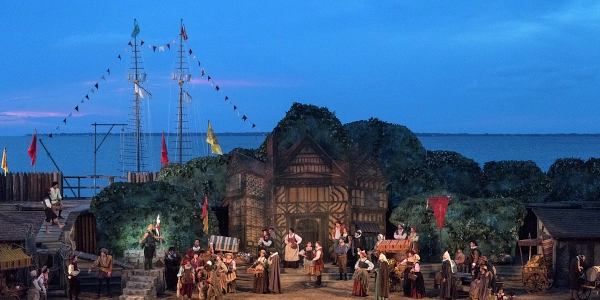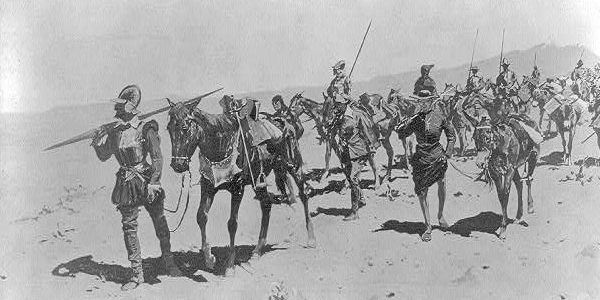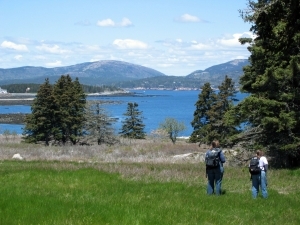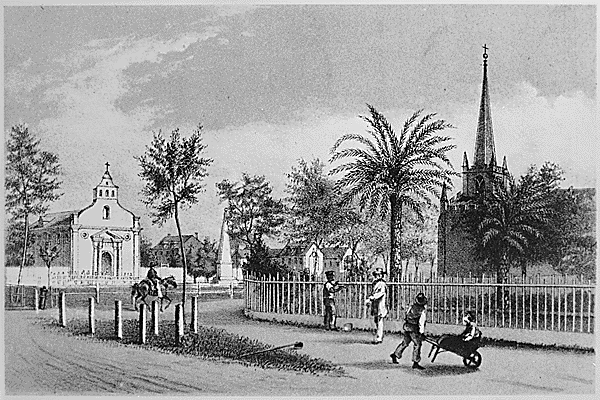Sponsor this page. Your banner or text ad can fill the space above.
Click here to Sponsor the page and how to reserve your ad.
-
Timeline
Detail - 1590
August 18, 1590 - John White's return trip to the Roanoke Island Colony finds no signs of the colonists, beyond the words CROATOAN and CRO carved into tree trunks. The fate of its people is unknown to this date, and is often referred to as the "Lost Colony of Roanoke Island."
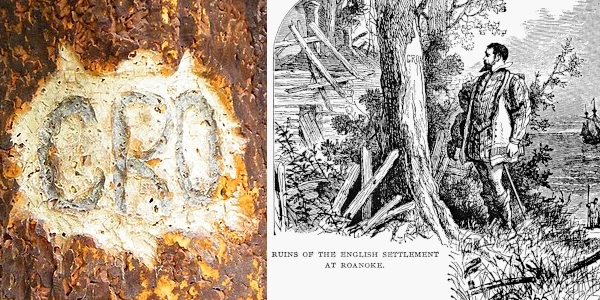
With the Spanish Armada defeated, Sir Walter Raleigh and John White began to make plans to return to the Roanoke Colony with additional supplies. It had been three years and the fate of the colony was completely unknown. Raleigh had already spent L40,000 on the colonial adventure and with the Spanish Armada saga ended, neither he nor Queen Elizabeth were willing to commit more funds to that expedition. However, John White, having more at stake with his daughter Eleanor, son-in-law Aninias, and granddaughter Virginia Dare at Roanoke, joined forces with Thomas Smith, Richard Hakuyt, and others to form a company that bought a right of trade in Virginia from Sir Walter Raleigh in March 1589. It was not his patent, but a limited arrangement. He would still be the chief governor and take a fifth of all gold and silver found.
Raleigh had not abandoned the colony or colonists. He felt a responsibility to the people he had sent to Virginia and wanted the area to be an English nation. While some contend that he "abandoned the poor colonists," it was not true. Even after the below effort by John White and company in 1590, Sir Walter Raleigh continued to send other expeditions to find the colonists, the last sailing in 1603 under Samuel Mace.


John White's Return, Colony Abandoned
John White and crew, in three ships, the Hopewell, John Evangelist, and the Little John sailed from Plymouth, England with two small shallops on March 20, 1590. The voyage was tumultuous. They reached Hatteras by August 15, and sighted smoke rising from Roanoke Island; a second fire burned southwest of Kindriker's Mountains. When John White's ships landed two days later, there was no sign of the tribe or the colonists, only the remnants of burning trees and grass. It was near the date of his granddaughter, Virginia Dare's third birthday. He traveled fifty miles toward Roanoke and Lane's fort. All he found on the fort and trees were the words CRO or CROATOAN, which confused him. Did that mean that the remnants of the colonists were now assimilated into Manteo's Algonquians, the Chowanoke Tribe, theorized now located near the Chowan River where the land was fertile? Or did it mean that they were unable to live off the meager supplies left behind and the hunting of game or crops they could grow, and did not survive? He had instructed them, in 1587, if they had to move, that they should carve the location in the colony fort or trees.
John White's Diary
The next morning being the 17 of August, our boates and company were prepared againe to goe up to Roanoak, but Captaine Spicer had then sent his boat ashore for fresh water, by meanes whereof it was ten of the clocke afternoone before we put from our ships which were then come to an anker within two miles of the shore. The Admirals boat was halfe way toward the shore, when Captaine Spicer put off from his ship. The Admirals boat first passed the breach, but not without some danger of sinking, for we had a sea brake into our boat which filled us halfe full of water, but by the will of God and carefull styrage of Captaine Cooke we came safe ashore, saving onely that our furniture, victuals, match and powder were much wet and spoyled. For at this time the winde blue at Northeast and direct into the harbour so great a gale, that the Sea brake extremely on the barre, and the tide went very forcibly at the entrance.
By that time our Admirals boat was halled ashore, and most of our things taken out to dry, Captaine Spicer came to the entrance of the breach with his mast standing up, and was halfe passed over, but by the rash and undiscreet styrage of Ralph Skinner his Masters mate, a very dangerous Sea brake into their boate and overset them quite, the men kept the boat some in it, and some hanging on it, but the next sea set the boat on ground, where it beat so, that some of them were forced to let goe their hold, hoping to wade ashore: but the Sea still beat them downe, so that they could neither stand nor swimme, and the boat twise or thrise was turned the keele upward, whereon Captaine Spicer and Skinner hung untill they sunke, and were seene no more. But foure that could swimme a litle kept themselves in deeper water and were saved by Captaine Cookes meanes, who so soone as he saw their oversetting, stripped himselfe, and foure other that could swimme very well, and with all haste possible rowed unto them, and saved foure. There were 11 in all and 7 of the chiefest were drowned, whose names were Edward Spicer, Ralph Skinner, Edward Kelly, Thomas Bevis, Hance the Surgion, Edward Kelborne, Robert Coleman.
This mischance did so much discomfort the saylers, that they were all of one mind not to goe any further to seeke the planters. But in the end by the commandement and perswasion of me and Captaine Cooke, they prepared the boates: and seeing the Captaine and me so resolute, they seemed much more willing.
Our boates and all things fitted againe, we put off from Hatorask, being the number of 19 persons in both boates: but before we could get to the place where our planters were left, it was so exceeding darke, that we overshot the place a quarter of a mile: there we espied towards the North ende of the Island the light of a great fire thorow the woods, to which we presently rowed: when wee came right over against it, we let fall our Grapnel neere the shore and sounded with a trumpet a Call, and afterwardes many familiar English tunes of Songs, and called to them friendly; but we had no answere, we therefore landed at day-breake, and comming to the fire, we found the grasse and sundry rotten trees burning about the place.
From hence we went thorow the woods to that part of the Iland directly over against Dasamongwepeuk, and from thence we returned by the water side, round about the North point of the Iland, untill we came to the place where I left our Colony in the yeere 1586. In all this way we saw in the sand the print of the Salvages feet of 2 or 3 sorts troaden the night, and as we entred up the sandy banke upon a tree, in the very browe thereof were curiously carved these faire Romane letters. C R o: which letters presently we knew to signifie the place, where I should find the planters seated.
Seated here means located or situated., according to a secret token agreed upon betweene them and me at my last departure from them, which was, that in any wayes they should not faile to write or carve on the trees or posts of the dores the name of the place where they should be seated; for at my comming away they were prepared to remove from Roanoak 50 miles into the maine. Therefore at my departure from them in An. 1587 I willed them, that if they should happen to be distressed in any of those places, that then they should carve over the letters or name, a Crosse ? in this forme, but we found no such signe of distresse.
And having well considered of this, we passed toward the place where they were left in sundry houses, but we found the houses taken downe, and the place very strongly enclosed with a high palisado of great trees, with cortynes and flankers very Fortlike, and one of the chiefe trees or postes at the right side of the entrance had the barke taken off, and 5 foote from the ground in fayre Capitall letters was graven CROATOAN without any crosse or signe of distresse; this done, we entred into the palisado, where we found many barres of iron, two pigges of Lead, foure yron fowlers, Iron sacker-shotte, and such like heavie thinges, throwen here and there, almost overgrowen with grasse and weedes. From thence wee went along by the water side, towards the poynt of the Creeke to see if we could find any of their botes or Pinnisse, but we could perceive no signe of them, nor any of the last Falkons and small Ordinance which were left with them, at my departure from them. At our returne from the Creeke, some of our Saylers meeting us, told us that they had found where divers chests had bene hidden, and long sithence digged up againe and broken up, and much of the goods in them spoyled and scattered about, but nothing left, of such things as the Savages knew any use of, undefaced.
Presently Captaine Cooke and I went to the place, which was in the ende of an olde trench, made two yeeres past by Captaine Amadas: wheere wee found five Chests, that had bene carefully hidden of the Planters, and of the same chests three were my owne, and about the place many of my things spoyled and broken, and my bookes tome from the covers, the frames of some of my pictures and Mappes rotten and spoyled with rayne, and my armour almost eaten through with rust; this could bee no other but the deede of the Savages our enemies at Dasamongwepeuk, who had watched the departure of our men to Croatoan; and as soone as they were departed digged up every place where they suspected any thing to be buried: but although it much grieved me to see such spoyle of my goods, yet on the other side I greatly joyed that I had safely found a certaine token of their safe being at Croatoan, which is the place where Manteo was borne, and the Savages of the Iland our friends.
When we had seene in this place so much as we could, we returned to our Boates, and departed from the shoare towards our shippes, with as much speede as we could: For the weather beganne to overcast, and very likely that a foule and stormie night would ensue. Therefore the same Evening with much danger and labour, we got our selves aboard, by which time the winde and seas were so greatly risen, that wee doubted our Cables and Anchors would scarcely holde untill Morning: wherefore the Captaine caused the Boate to be manned by five lusty men, who could swimme all well, and sent them to the little Iland on the right hand of the Harbour, to bring aboard sixe of our men, who had filled our caske with fresh water: the Boate the same night returned aboard with our men, but all our Caske ready filled they left behinde, unpossible to bee had aboard without danger of casting away both men and Boates: for this night prooved very stormie and foule.
The next Morning it was agreed by the Captaine and my selfe, with the Master and others, to wey anchor, and goe for the place at Croatoan, where our planters were: for that then the winde was good for that place, and also to leave that Caske with fresh water on shoare in the Iland untill our returne. So then they brought the cable to the Capston, but when the anchor was almost adecke, the Cable broke, by meanes whereof we lost another Anchor, wherewith we drove so fast into the shoare, that wee were forced to let fall a third Anchor: which came so fast home that the Shippe was almost aground by Kenricks mounts: so that we were forced to let slippe the Cable ende for ende. And if it had not chanced that wee had fallen into a chanell of deeper water, closer by the shoare then wee accompted of, wee could never have gone cleare of the poynt that lyeth to the Southwardes of Kenricks mounts. Being thus cleare of some dangers, and gotten into deeper waters, but not without some losse: for wee had but one Cable and Anchor left us of foure, and the weather grew to be fouler and fouler; our victuals scarse, and our caske and fresh water lost: it was therefore determined that we should goe for Saint John or some other Iland to the Southward for fresh water.
As stated above, once noting their absence along the coast or at the former site of the fort, John White and his crew took the first thought and attempted to sail fifty miles further south to Croatoan Island. However, storms prevented it, driving his ship out to sea. They returned back to England then, considering the Lost Colony of Roanoke, as a fatal attempt to colonize Virginia, or that some may have survived, but they now lived with the natives. If survival is true, there are various theories about where they might have gone; to Croatoan Island, to live with the Chesapeake Indians on the south side of Chesapeake Bay, or perhaps to the land of the Chowanoks in Albermarle Sound or the Tuscarora near the Roanoke River.
No matter their fate, the Roanoke Colony was abandoned by them and/or White on his resupply mission. The remaining ships of White's excursion returned to England on October 28, 1590. It would take until 1607 and the Jamestown Expedition for the English to return and have some success. There are historians who also believe that the chief of the Powhatan Indians, Wahunsonacock, father of Pocahontas, killed the Roanoke survivors, before they could reunite with the Jamestown colonists.
The next morning being the 17 of August, our boates and company were prepared againe to goe up to Roanoak, but Captaine Spicer had then sent his boat ashore for fresh water, by meanes whereof it was ten of the clocke afternoone before we put from our ships which were then come to an anker within two miles of the shore. The Admirals boat was halfe way toward the shore, when Captaine Spicer put off from his ship. The Admirals boat first passed the breach, but not without some danger of sinking, for we had a sea brake into our boat which filled us halfe full of water, but by the will of God and carefull styrage of Captaine Cooke we came safe ashore, saving onely that our furniture, victuals, match and powder were much wet and spoyled. For at this time the winde blue at Northeast and direct into the harbour so great a gale, that the Sea brake extremely on the barre, and the tide went very forcibly at the entrance.
By that time our Admirals boat was halled ashore, and most of our things taken out to dry, Captaine Spicer came to the entrance of the breach with his mast standing up, and was halfe passed over, but by the rash and undiscreet styrage of Ralph Skinner his Masters mate, a very dangerous Sea brake into their boate and overset them quite, the men kept the boat some in it, and some hanging on it, but the next sea set the boat on ground, where it beat so, that some of them were forced to let goe their hold, hoping to wade ashore: but the Sea still beat them downe, so that they could neither stand nor swimme, and the boat twise or thrise was turned the keele upward, whereon Captaine Spicer and Skinner hung untill they sunke, and were seene no more. But foure that could swimme a litle kept themselves in deeper water and were saved by Captaine Cookes meanes, who so soone as he saw their oversetting, stripped himselfe, and foure other that could swimme very well, and with all haste possible rowed unto them, and saved foure. There were 11 in all and 7 of the chiefest were drowned, whose names were Edward Spicer, Ralph Skinner, Edward Kelly, Thomas Bevis, Hance the Surgion, Edward Kelborne, Robert Coleman.
This mischance did so much discomfort the saylers, that they were all of one mind not to goe any further to seeke the planters. But in the end by the commandement and perswasion of me and Captaine Cooke, they prepared the boates: and seeing the Captaine and me so resolute, they seemed much more willing.
Our boates and all things fitted againe, we put off from Hatorask, being the number of 19 persons in both boates: but before we could get to the place where our planters were left, it was so exceeding darke, that we overshot the place a quarter of a mile: there we espied towards the North ende of the Island the light of a great fire thorow the woods, to which we presently rowed: when wee came right over against it, we let fall our Grapnel neere the shore and sounded with a trumpet a Call, and afterwardes many familiar English tunes of Songs, and called to them friendly; but we had no answere, we therefore landed at day-breake, and comming to the fire, we found the grasse and sundry rotten trees burning about the place.
From hence we went thorow the woods to that part of the Iland directly over against Dasamongwepeuk, and from thence we returned by the water side, round about the North point of the Iland, untill we came to the place where I left our Colony in the yeere 1586. In all this way we saw in the sand the print of the Salvages feet of 2 or 3 sorts troaden the night, and as we entred up the sandy banke upon a tree, in the very browe thereof were curiously carved these faire Romane letters. C R o: which letters presently we knew to signifie the place, where I should find the planters seated.
Seated here means located or situated., according to a secret token agreed upon betweene them and me at my last departure from them, which was, that in any wayes they should not faile to write or carve on the trees or posts of the dores the name of the place where they should be seated; for at my comming away they were prepared to remove from Roanoak 50 miles into the maine. Therefore at my departure from them in An. 1587 I willed them, that if they should happen to be distressed in any of those places, that then they should carve over the letters or name, a Crosse ? in this forme, but we found no such signe of distresse.
And having well considered of this, we passed toward the place where they were left in sundry houses, but we found the houses taken downe, and the place very strongly enclosed with a high palisado of great trees, with cortynes and flankers very Fortlike, and one of the chiefe trees or postes at the right side of the entrance had the barke taken off, and 5 foote from the ground in fayre Capitall letters was graven CROATOAN without any crosse or signe of distresse; this done, we entred into the palisado, where we found many barres of iron, two pigges of Lead, foure yron fowlers, Iron sacker-shotte, and such like heavie thinges, throwen here and there, almost overgrowen with grasse and weedes. From thence wee went along by the water side, towards the poynt of the Creeke to see if we could find any of their botes or Pinnisse, but we could perceive no signe of them, nor any of the last Falkons and small Ordinance which were left with them, at my departure from them. At our returne from the Creeke, some of our Saylers meeting us, told us that they had found where divers chests had bene hidden, and long sithence digged up againe and broken up, and much of the goods in them spoyled and scattered about, but nothing left, of such things as the Savages knew any use of, undefaced.
Presently Captaine Cooke and I went to the place, which was in the ende of an olde trench, made two yeeres past by Captaine Amadas: wheere wee found five Chests, that had bene carefully hidden of the Planters, and of the same chests three were my owne, and about the place many of my things spoyled and broken, and my bookes tome from the covers, the frames of some of my pictures and Mappes rotten and spoyled with rayne, and my armour almost eaten through with rust; this could bee no other but the deede of the Savages our enemies at Dasamongwepeuk, who had watched the departure of our men to Croatoan; and as soone as they were departed digged up every place where they suspected any thing to be buried: but although it much grieved me to see such spoyle of my goods, yet on the other side I greatly joyed that I had safely found a certaine token of their safe being at Croatoan, which is the place where Manteo was borne, and the Savages of the Iland our friends.
When we had seene in this place so much as we could, we returned to our Boates, and departed from the shoare towards our shippes, with as much speede as we could: For the weather beganne to overcast, and very likely that a foule and stormie night would ensue. Therefore the same Evening with much danger and labour, we got our selves aboard, by which time the winde and seas were so greatly risen, that wee doubted our Cables and Anchors would scarcely holde untill Morning: wherefore the Captaine caused the Boate to be manned by five lusty men, who could swimme all well, and sent them to the little Iland on the right hand of the Harbour, to bring aboard sixe of our men, who had filled our caske with fresh water: the Boate the same night returned aboard with our men, but all our Caske ready filled they left behinde, unpossible to bee had aboard without danger of casting away both men and Boates: for this night prooved very stormie and foule.
The next Morning it was agreed by the Captaine and my selfe, with the Master and others, to wey anchor, and goe for the place at Croatoan, where our planters were: for that then the winde was good for that place, and also to leave that Caske with fresh water on shoare in the Iland untill our returne. So then they brought the cable to the Capston, but when the anchor was almost adecke, the Cable broke, by meanes whereof we lost another Anchor, wherewith we drove so fast into the shoare, that wee were forced to let fall a third Anchor: which came so fast home that the Shippe was almost aground by Kenricks mounts: so that we were forced to let slippe the Cable ende for ende. And if it had not chanced that wee had fallen into a chanell of deeper water, closer by the shoare then wee accompted of, wee could never have gone cleare of the poynt that lyeth to the Southwardes of Kenricks mounts. Being thus cleare of some dangers, and gotten into deeper waters, but not without some losse: for wee had but one Cable and Anchor left us of foure, and the weather grew to be fouler and fouler; our victuals scarse, and our caske and fresh water lost: it was therefore determined that we should goe for Saint John or some other Iland to the Southward for fresh water.
New Efforts to Find Archaeological Remnants of Roanoke Colony
In 2025, iron trash was discovered on North Carolina's Hatteras Island. To some archaeologists, this suggests that the Lost Colony of Roanoke ended up in that region. Two large piles were found, including hammer scale, which is a byproduct of hammersmithing, perhaps while the colonists were repurposing iron material into nails. They were located in a thick shell midden from an Indigenous tribe that contained no other European material. Carbon dating states that it comes from the time of the Lost Colony, and that the natives did not use iron forging technology at that time. Other historians are not certain, claiming that it could have been from other explorers sailing up the East Coast.
For those wishing to visit the remnants or recreations of the Lost Colony of Roanoke, you should visit Fort Raleigh National Historic Site. Located on Roanoke Island, you can explore the voyages, people, the reconstructed Earthen Fort, and clues about what might have happened to the Lost Colony. There is also history about the native Roanoke tribe, as well as the history of the land and the Freedman's Colony.
Image above: Montage (left) Prop of Lost Colony tree from play, 2011, Sarah Stierch. Courtesy Wikipedia Commons (CC BY 4.0) and Raleigh National Historic Site, National Park Service; (right) Engraving depicting John White finding the ruins of the Roanoke colony in 1590, 1893, John Parker Davis, Columbus and Columbia: A Pictorial History of the Man and the Nation. Courtesy Wikipedia Commons. Below: Scene from "The Lost Colony" a play held every summer in Manteo, North Carolina on Roanoke Island, 2017, Carol Highsmith. Courtesy Library of Congress. Source info: "Sir Walter Raleigh," poetryfoundation.org; "Sir Walter Raleigh," 1909, Frederick A. Ober; "Sir Walter Ralegh, A Biography" 2008, William Stebbing, Gutenberg Project; "Croatan the Untold Story," "John White, the Lost Colony, and the Croatoan," 2024, Eric Klingelhofer, Where Did the Roanoke Colony Go," James Horn, firstcolonyfoundation.org; "Primary Source, John White Searches for the Colonists," ncpedia.org; "The Fifth Voyage of M. John White, 1590, Early English and French Voyages," Chiefly from Richard Hakluyt; "John White Returns to Roanoke," encyclopediavirginia.org; Library of Congress; digitalhistory.uh.edu; "John White's Attempt to Rescue the Roanoke Colonists," nationalhumanitiescenter.org; "Lost Colony of Roanoke may have assimilated into Indigenous society, archaeologist claims - but not everyone is convinced," 2025, Kristina Killgrove, livescience.com; Wikipedia.
